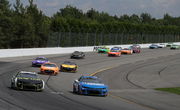
via Imago
Chris Buescher (17), Daniel Suarez (99), Denny Hamlin (11), Justin Haley (31), Ty Dillon (42), Aric Almirola (10) and Ricky Stenhouse Jr. (47) are involved in a multi-car accident between turns 1 and 2 during a NASCAR Cup Series auto race at Daytona International Speedway, Sunday, Aug. 28, 2022, in Daytona Beach, Fla. (AP Photo/Dow Graham)

via Imago
Chris Buescher (17), Daniel Suarez (99), Denny Hamlin (11), Justin Haley (31), Ty Dillon (42), Aric Almirola (10) and Ricky Stenhouse Jr. (47) are involved in a multi-car accident between turns 1 and 2 during a NASCAR Cup Series auto race at Daytona International Speedway, Sunday, Aug. 28, 2022, in Daytona Beach, Fla. (AP Photo/Dow Graham)
From the rugged dirt tracks to the sleek super speedways, Goodyear and NASCAR have been breaking new ground in performance and innovation for nearly seven decades. Goodyear’s journey in crafting and providing race tires kicked off in 1954, marking a partnership with NASCAR that stands as one of the longest in the annals of racing. As the sport evolved, so did the Goodyear Eagle race tires, paving the way for groundbreaking tire technology, including the 18-inch bead diameter tire that’s now a staple on today’s NASCAR Next Gen stock cars.
However, 2023 showed a different side of the firm, with several instances of tire failures mid-race. These mishaps did more than just alter the trajectory of the championship; they also dented Goodyear’s reputation to a certain degree. While losing a race because of tire issues is unfortunate, the potential risk to lives from such failures is a concern that overshadows everything else.
ADVERTISEMENT
Article continues below this ad
The Goodyear controversy: Tragic tire failures in NASCAR’s history
The 2000s saw a rocky road for Goodyear and NASCAR, especially when Tony Stewart took a public stand in 2009, slamming the manufacturer for poor tire quality. He pointed fingers at Goodyear after both Stewart-Haas Racing cars suffered damage at Daytona International Speedway. But this wasn’t the first time Goodyear faced serious scrutiny.
Years earlier, in a darker chapter, two promising NASCAR drivers, Jimmy Pardue and Billy Wade, tragically lost their lives during Goodyear tire tests at Charlotte Motor Speedway and Daytona.
Jimmy Pardue, on the cusp of a shining career, met his untimely demise on September 22, 1964, during a tire test. Just a year earlier, the North Carolina native had hit a high note, securing pole position in the World 600. Sadly, his life was cut short at the same track where Fireball Roberts had tragically passed away months before. During a Goodyear tire test for the upcoming National 400, Pardue clocked a lap at 143 mph–2 mph over the official track record. But on the following lap, disaster struck. Though the exact cause remains a mystery, it’s believed to be either a tire blowout or mechanical failure, and not driver error.
The second heart-wrenching incident involved Billy Wade at Daytona. Wade had rocketed to fame with a record-breaking streak of victories, becoming the only driver in history to win his first four races consecutively. However, this rising star was sadly extinguished in January 1965. While testing tires for Goodyear, a tire failure resulted in a devastating crash. Traveling over 170 mph, spectators heard a tire pop, and Wade’s car violently collided with the wall. Despite no fire or rollover, the impact was so severe that he was pronounced dead at the scene because of head and internal injuries.
In a twisted turn of events, Wade was in Charlotte when Pardue lost his life. Reports later surfaced that Wade’s seat had detached, causing the fatal injuries upon impact. Initially, it was suggested that the tire burst post-impact, but many believe, to this day, that the tire failure was the root cause of the crash, a narrative downplayed by Goodyear and NASCAR amidst negative press. In just six months between mid-1964 and early 1965, the NASCAR community mourned the loss of two racers at the height of their careers, both in their early 30s.
While Goodyear has since significantly upgraded their tires, and drivers like Dale Earnhardt Jr have defended the company, there’s still hesitance. Despite his statements in favor of Goodyear, Earnhardt Jr himself had reservations about sealing the deal with them.
Trending
Dale Earnhardt Jr switches lanes from Goodyear to Hoosier
Just a few weeks after backing Goodyear, Dale Earnhardt Jr. made a surprising move by joining forces with their competitor for his racing series. In a tweet from December, Earnhardt Jr spilled the beans: “Hoosier has reimagined their short track tire for asphalt in 2024. The @CARSTour is excited to hit the track with the ST2 next season.” The news came right after he hinted at an upcoming partnership with Hoosier on The Money Lap podcast, marking a shift in the short track and grassroots racing scene.
ADVERTISEMENT
Article continues below this ad
However, not too long ago on his podcast, Earnhardt Jr. was singing a different tune. He discussed Goodyear’s commitment to developing robust tires for next-gen cars, ones that could handle the heat of the race. What’s interesting is he mentioned Goodyear’s NASCAR role wasn’t about turning a profit.
“They’re not in NASCAR to make money. They’re not making money in NASCAR. They break events. […] They’re making money during the week selling tires to all of us customers on the street. And if all their racing tires are falling apart on the racetrack, they don’t sell many tires on the street. So they cannot have problems on Sunday.” said Earnhardt Jr.
ADVERTISEMENT
Article continues below this ad
This unexpected shift in his stance from backing Goodyear to signing with Hoosier certainly raised some eyebrows. But what changes his mind in a matter of weeks? Well, the answer to that is known to Earnhardt only.
Watch This Story: 32 Classic Nascar Cup Series Cars Are Up for Sale
ADVERTISEMENT
ADVERTISEMENT
ADVERTISEMENT
ADVERTISEMENT






